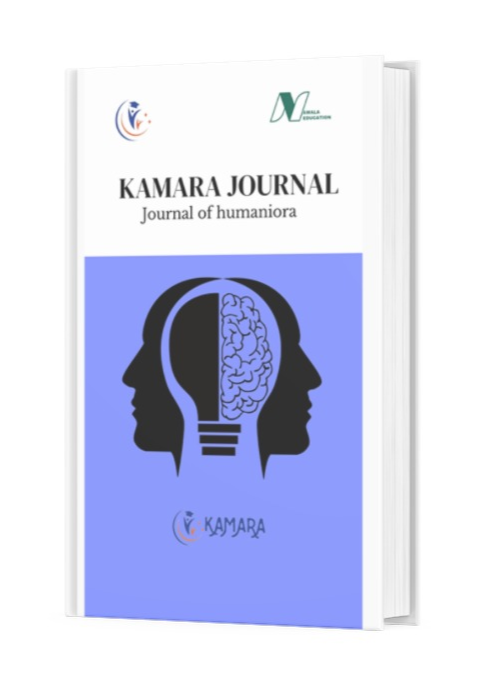Transformation Of Batik As A Symbol Of Nationalism And National Identity
DOI:
https://doi.org/10.62872/63x5wa58Keywords:
National Identity , Batik As A Symbol Of Nationalism , cultural festivalAbstract
Batik, as Indonesia's cultural heritage, has gone through a significant transformation, making it a symbol of nationalism and deep national identity. As a cultural expression that reflects the diversity of ethnicities, religions, and customs in Indonesia, batik is now not only used in state events, but also in everyday life. Each batik motif originating from various regions contains rich philosophical and historical meanings, illustrating the richness of Indonesia's local culture. The recognition of batik by UNESCO as an Intangible Cultural Heritage in 2009 further strengthened its position as a symbol of national pride that is recognized at the international level. The main challenge facing batik is to maintain its authenticity and quality amidst globalization and the rise of mass production that does not follow traditional batik techniques. Therefore, it is important to preserve batik through education and training of batik skills for the younger generation, as well as conducting sustainable promotion in the global market. Batik also provides a significant economic impact, creating jobs for local artisans and introducing Indonesian culture to the international world. With design and technique innovations that still emphasize traditional values, batik can continue to survive and thrive in the modern era, playing an important role in strengthening Indonesia's cultural identity at the global level.
Downloads
References
Amalia, D., Rosdiana, A., Al Azizi, N., & Wulandari, A. (2024). Semiotika Batik Jepara sebagai Bentuk Identitas Budaya Lokal Masyarakat Jepara. Entita: Jurnal Pendidikan Ilmu Pengetahuan Sosial Dan Ilmu-Ilmu Sosial, 6(1), 1–14. https://doi.org/10.19105/ejpis.v6i1.12169
Aragon, L. V. (2022). Copyrighting Culture for the Nation? Intangible Property Nationalism and the Regional Arts of Indonesia. International Journal of Cultural Property, 19(3), 269–312. https://doi.org/10.1017/s0940739112000203
Athariq, D., Permatasari, D., Ardiansyah, D., & Suciyati, P. (2024). Analisis Proses Pembuatan Batik Guna Membentuk Karakter Dan Moral Budaya Para Karyawan Atau Pengrajin Di Sanggar Batik Liza Mangrove Desa Pematang Johar Deli Serdang. JURNAL ILMIAH EKONOMI, MANAJEMEN, BISNIS DAN AKUNTANSI, 1(2), 460-466. https://doi.org/10.36987/jumsi.v3i1.3960
Djuhara, U. (2014). Pergeseran Fungsi Seni Tari sebagai Upaya Pengembangan dan Pelestarian Kebudayaan. Jurnal Seni Makalangan, 1(2). https://doi.org/10.26740/geter.v3n1.p93-104
Evno, K. M., Setiawan, D. V., & Dimi, A. (2024). Peranan Culture Terhadap Batik Pekalongan Sebagai Daya Tarik Nasional Terhadap Perkembangan Zaman. MULTIPLE: Journal of Global and Multidisciplinary, 2(2), 1216-1228. https://doi.org/10.24821/corak.v2i1.2330
Hakim, A. R., & Darojat, J. (2023). Pendidikan Multikultural dalam Membentuk Karakter dan Identitas Nasional. Jurnal Ilmiah Profesi Pendidikan, 8(3), 1337–1346. https://doi.org/10.29303/jipp.v8i3.1470
Hakim, L. M. (2018). Batik Sebagai Warisan Budaya Bangsa dan Nation Brand Indonesia. Nation State Journal of International Studies, 1(1), 61–90. https://doi.org/10.24076/nsjis.2018v1i1.90
Ikhwanul Qiram, M. T. (2018). Plagiasi Batik Nusantara Kaya Akan Keragaman Dan Memiliki Karakteristik Di Tiap Daerah Asalnya. JURNAL LEKESAN. https://doi.org/10.31091/lekesan.v1i2.407
Indrawati, M., & Sari, Y. I. (2024). MEMAHAMI WARISAN BUDAYA DAN IDENTITAS LOKAL DI INDONESIA. Jurnal Penelitian dan Pendidikan IPS, 18(1), 77-85. https://doi.org/10.61476/1t4v4m78
Karlina, A., Nurochman, I., Risanto, W., Seliah, S., & Selasi, D. (2024). EKSPLORASI PROSES PEMBUATAN BATIK TULIS DI PLERED: TEHNIK, TRADISI DAN INOVASI. Neraca: Jurnal Ekonomi, Manajemen dan Akuntansi, 2(6), 622-626. https://doi.org/10.59188/covalue.v15i01.4395
Nabillah, A. S., Rustriningsih, R., & Siregar, W. Z. B. (2024). Peran Perempuan Dalam Industri Batik Rifaiyah. Al-Mada: Jurnal Agama, Sosial, dan Budaya, 7(3), 637-655. https://doi.org/10.31538/almada.v3i1.530
Nasrulloh, N. (2022). Implementasi Etika Bisnis Islam dan Transformasi Digital UMKM Madura dalam Mendukung Ketercapaian Sustainable Development Goals. JES (Jurnal Ekonomi Syariah), 7(1), 63–75. https://doi.org/10.30736/jesa.v7i1.183
Nursanty, E., Rusmiatmoko, D., Destiawan, W., Husni, M. F. D., & Yuliati, Y. (2023). Kampung Jamu: Pilar Peningkatan Kemampuan Bersaing Kota Semarang. Perigel: Jurnal Penyuluhan Masyarakat Indonesia, 2(3), 38–47. https://doi.org/10.56444/perigel.v2i3.1050
Prasetyo, S. A. (2016). Karakteristik motif batik Kendal interpretasi dari wilayah dan letak geografis. Imajinasi: Jurnal Seni, 10(1), 51-60. https://doi.org/10.12962/j23373520.v8i1.41627
Putri, A. S. H., Herrizona, F. P., & Kurniawan, N. K. P. (2024). Pengaruh Tren Mode Berkain pada Generazi Z terhadap Upaya Revitalisasi dan Aktualisasi Identitas Budaya dalam Perspektif Etika. Jurnal Ilmiah Wahana Pendidikan, 10(14), 243-252. https://doi.org/10.17977/um020v14i22020p1-13
Resmawati, W. I., & Alrianingrum, S. (2014). Fungsi Gedung Taman Budaya Jawa Timur sebagai Wadah Aktivitas Seni Tradisional Jawa Timur Tahun 1978-1988. AVATARA, Pendidikan Sejarah, 2(3), 292-303. https://doi.org/10.30738/cilpa.v8i1.13054
Semuel, H., Mangoting, Y., & Hatane, S. E. (2022). Makna Kualitas dan Kinerja Tenun Tradisional Indonesia Kolaborasi Budaya Nasional dan Budaya Organisasi. Makna Kualitas dan Kinerja Tenun Tradisional Indonesia Kolaborasi Budaya Nasional dan Budaya Organisasi. https://doi.org/10.22146/bip.8273
Sari, I. P., Wulandari, S., & Maya, S. (2019). Urgensi Batik Mark dalam Menjawab Permasalahan Batik Indonesia (Studi Kasus di Sentra Batik Tanjung Bumi). Sosio E-Kons, 11(1), 16. https://doi.org/10.30998/sosioekons.v11i1.2932
Sofyani, W. O. W. (2017). Tenun Buton dalam multikultural wastra Nusantara. Seri Kebudayaan, 1, 109-199. https://doi.org/10.24114/jupiis.v10i1.8831.s617
Steelyana, E. (2012). Batik, A Beautiful Cultural Heritage that Preserve Culture and Supporteconomic Development in Indonesia. Binus Business Review, 3(1), 116. https://doi.org/10.21512/bbr.v3i1.1288
Subhan, S., Syahadatina, R., Ustman, U., Surya, C. L., & Junaidi, J. (2022). Pemanfaatan Digitalisasi Untuk Meningkatkan Kemampuan Pelaporan Perpajakan Bagi Pengrajin Batik di Kabupaten Pamekasan. Indonesia Berdaya, 3(4), 1021–1028. https://doi.org/10.47679/ib.2022337
Tandjung, J. E. (2017). Formulation of a Trade-Oriented Indonesian Position on the Protection of Traditional Cultural Expressions (TCEs): A Case Study of Indonesian Batik as Indonesia Enters the ASEAN Economic Community. https://doi.org/10.47191/ijsshr/v6-i7-85
Untari, D. T., Darusman, D., Prihatno, J., & Arief, H. (2019). STRATEGI PENGEMBANGAN KULINER TRADISIONAL BETAWI DI DKI JAKARTA. EKUITAS (Jurnal Ekonomi Dan Keuangan), 2(3), 313–340. https://doi.org/10.24034/j25485024.y2018.v2.i3.4011
Varanida, D. (2016). Komunikasi dalam Integrasi Sosial Budaya antar Etnis Tionghoa dan Pribumi di Singkawang. Jurnal Ilmu Komunikasi, 14(1), 13-21. https://doi.org/10.47233/jkomdis.v3i2.892
Xiao, M. (2024). Innovative Applications and Market Impact of Indonesian Batik in Modern Fashion. Studies in Art and Architecture, 3(2), 62–66. https://doi.org/10.56397/saa.2024.06.13
Downloads
Published
Issue
Section
License
Copyright (c) 2024 Sahwa Desma (Author)

This work is licensed under a Creative Commons Attribution-ShareAlike 4.0 International License.












